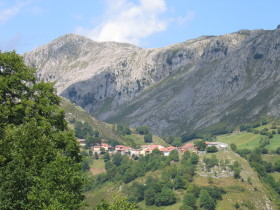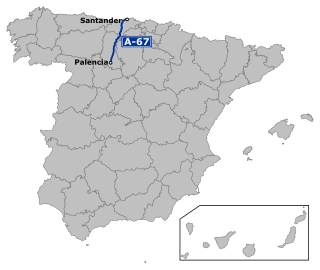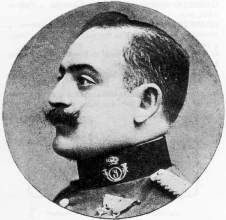
Cantabria is an autonomous community and province in northern Spain with Santander as its capital city. It is called a comunidad histórica, a historic community, in its current Statute of Autonomy. It is bordered on the east by the Basque autonomous community, on the south by Castile and León, on the west by the Principality of Asturias, and on the north by the Cantabrian Sea.

Euzko Gudarostea was the name of the army commanded by the Basque Government during the Spanish Civil War. It was formed by Basque nationalists, socialists, communists, anarchists and republicans under the direction of lehendakari José Antonio Aguirre and coordinating with the army of the Second Spanish Republic. It fought the troops of Francisco Franco during 1936 and 1937. It surrendered to the Italian Corpo Truppe Volontarie at Santoña, while the rest of the Republican army kept fighting until 1939. This event is called the Santoña Agreement, Pact of Santoña, or Treason of Santoña by some Spanish leftists.

The Battle of El Mazucu was fought between 6 and 22 September 1937, between the Republican and Nationalist armies during the Spanish Civil War as a part of the War in the North campaign. The Republican defence of El Mazucu and the surrounding mountains halted the Nationalist advance into eastern Asturias, despite their forces being outnumbered sevenfold. After weeks of intense fighting over extreme terrain the defenders were eventually overwhelmed, and the Nationalists were then able to link up with their forces advancing from León, leading to the fall of Gijón and the abandonment of Asturias, the last Republican province in North-West Spain.
In 1937, the Nationalists, under the leadership of Francisco Franco began to establish their dominance. An important element of support was their greater access to foreign aid, with their German and Italian allies helping considerably. This came just as the French ceased aid to the Republicans, who continued, however, to be able to buy arms from the Soviet Union. The Republican side suffered from serious divisions among the various communist and anarchist groupings within it, and the communists undermined much of the anarchists' organisation.

Cantabrian cuisine is the cuisine from Cantabria, an autonomous community in northern Spain. It includes seafood from the Cantabrian Sea, salmon and trout from the upper basins of the rivers, vegetables and dairy products from the valleys, and veal and game from the Cantabrian mountains.

The Autovía A-67 is a highway in north west Spain. It connects the Cantabrian Atlantic Coast at Santander to Palencia. It follows the route of the N-611.

The Cantabria autonomous football team is the regional football team for Cantabria, Spain. They are not affiliated with FIFA or UEFA and therefore are only allowed to play friendly matches.

The War in the North was the campaign of the Spanish Civil War in which the Nationalist forces defeated and occupied the parts of northern Spain that had remained loyal to the Republican government.

Campoo is a comarca (district) of Cantabria (Spain) located in the High Ebro. With an area of slightly more than 1,000 km2, it includes the municipalities of Hermandad de Campoo de Suso, Campoo de Enmedio, Campoo de Yuso, Valdeolea, Valdeprado del Río, Valderredible, Reinosa, Las Rozas de Valdearroyo, Santiurde de Reinosa, Pesquera, and San Miguel de Aguayo. The local inhabitants are called Campurrians . Its highest elevation is the Cuchillón peak, and the lowest is Pesquera, with the capital, Reinosa at 850 m.
The Santoña Agreement, Pact of Santoña or Santoña Treason, was an agreement signed in the town of Guriezo, near Santoña, Cantabria, on 24 August 1937, during the Spanish Civil War, between politicians close to the Basque Nationalist Party, fighting for the Spanish Republicans, and Italian forces, fighting for Francisco Franco, treaty which, according to modern historiography, is considered a treason against the Spanish Republic.

The Basque Republic was a project for an independent Basque Country proposed in 1941 by Manuel de Irujo, at that moment the main representative of the Basque Government in London.

The Battle of Irún was the critical battle of the Campaign of Gipuzkoa prior to the War in the North, during the Spanish Civil War. The Nationalist Army, under Alfonso Beorlegui, captured the city of Irún cutting off the northern provinces of Gipuzkoa, Biscay, Santander, and Asturias from their source of arms and support in France.
The Isaac Puente battalion was a battalion of the Confederación Nacional del Trabajo (CNT) from the Basque Country which was active during the Spanish Civil War from September 1936 to October 1937. It was named after Isaac Puente and was nº 3 of the Milicias Antifascistas de la CNT and nº 11 of the Euzko Gudarostea. The battalion participated in the Villarreal Offensive, the Vizcaya Campaign, the Battle of Santander, the Asturias Campaign and the Battle of El Mazuco.

The Biscay Campaign was an offensive of the Spanish Civil War which lasted from 31 March to 1 July 1937. 50,000 men of the Eusko Gudarostea met 65,000 men of the insurgent forces. After heavy combats the Nationalist forces with a crushing material superiority managed to occupy the city of Bilbao and the Biscay province.

The Asturias Offensive was an offensive in Asturias during the Spanish Civil War which lasted from 1 September to 21 October 1937. 45,000 men of the Spanish Republican Army met 90,000 men of the Nationalist forces.
Adolfo Prada Vaquero (1883–1962) was a military officer of the Spanish Army. He remained loyal to the Republican government during the Spanish Civil War.

Francisco Llano de la Encomienda was a Spanish soldier who served in Africa and was promoted to General in 1931. During the Spanish Civil War (1936–39) he remained loyal to the Second Spanish Republic. He was in command of the troops in Barcelona when a military revolt was attempted on 19 July 1936. He was imprisoned by the rebels, and after the revolt was relieved of his command. He was given command of the Army of the North in November 1936 but was not able to form a unified command. He was handicapped by regional jealousies and a mixed command of regular troops and militia. He was dismissed in May 1937 shortly before the north of Spain fell to the insurgents. He took refuge in Mexico after the war.

Mariano Gámir Ulíbarri was a Spanish general who fought on the Republican side during the Spanish Civil War (1936–39). He was Basque, a career soldier, and had no political affiliation. He commanded a brigade on the Aragon front in the early months of the war, then was assigned to command the Basque forces in May 1937. He retreated westward from Basque country in June 1937 when attacked by greatly superior Nationalist forces. Soon after he was given command of the Army of the North, and tried to defend Santander. When this fell, he moved to Asturias, where he was replaced as commander. He escaped, returned to Valencia, and was briefly given command of a brigade, but was moved to a less responsible post due to doubts about his ability. After the war he lived in exile in France, where he wrote his memoirs, before being allowed to return to Spain a few years before his death.
José García Vayas was a Spanish soldier who remained loyal to the Second Spanish Republic during the Spanish Civil War (1936–39), during which he commanded the forces in Santander. After the civil war he was forced into exile in France.

The Brigades of Navarre, also known as Navarrese Brigades, were six brigades composed mainly of Navarrese requeté that participated in the Spanish Civil War. They constituted the main nucleus of the Nationalist Army that carried out the Biscay Campaign, including the decisive battle of Bilbao. Once the brigades won the War in the North, they became divisions.














